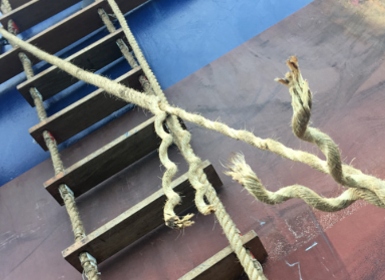
The Australian Maritime Safety Authority (AMSA) recently issued a marine notice reminding shipowners, operators, masters, crews, recognised organisations, marine pilots and pilotage providers of the obligation to provide safe pilot transfer arrangements.
AMSA notes with concern that since November 2017, several pilots’ lives have been placed at risk, in six separate incidents where man ropes have parted, or its securing point has failed. In addition, AMSA regularly receives reports and complaints about non-compliant pilot transfer arrangements.
Shipowners, operators, masters and crews are reminded that pilot transfer arrangements, including pilot ladders, must comply with Marine Order 21 (Safety and emergency arrangements) 2016 (MO21).
MO21 implements Australia’s obligations under the International Convention for the Safety of Life at Sea (SOLAS) Chapter V Regulation 23 (SOLAS V/23).
Pilot transfer arrangement standards
Whenever a pilot or other person embarks or disembarks from a ship by ladder, they entrust their safety to the pilot transfer arrangements provided by the ship and the pilot boat crew.
The requirements in SOLAS V/23 are the minimum standards for equipment installed and arrangements for pilot transfers on ships on or after July 1, 2012. The IMO standards can be found in:
IMO Resolution A.1045(27) – Pilot transfer arrangements, and
IMO Resolution A.1108(29) – Amendments to the Recommendations on Pilot Transfer Arrangements (Resolution A.1045(27)).
SOLAS V/23.2.3 also states a pilot ladder shall be certified by the manufacturer as complying with SOLAS V/23 or “with an international standard acceptable to the Organisation” and refers to ISO 799:2019 “Ships and marine technology – pilot ladders”.
Compliance with this particular provision of SOLAS V/23 can be met when a manufacturer has certified the pilot ladder complies with either of the above standards, noting they are not identical.
Paragraph 10.1 of Part A of the International Safety Management Code (ISM) requires vessel operators to establish procedures to ensure a ship is maintained in conformity with the relevant rules and regulations, including pilot transfer arrangements. Such procedures should include regular inspections of the pilot transfer arrangement and storage of such equipment when not in use.
Pilot transfer arrangements
IMO Circular MSC.1/Circ.1428 illustrates the pilot transfer arrangements required by SOLAS V/23.
Strict attention should be paid to the freeboard of the vessel to determine whether a combination ladder needs to be rigged and, if a combination ladder is required, attention should be paid to arrangements for securing such ladders to the vessel’s side.
Clear and efficient communication with the pilot boat master is essential to ensure the safety of the pilot transfer arrangements before a person uses the ladder. The pilot boat master is best positioned to judge correct height of the bottom of the ladder and identify any potential issues with the ladder or ropes once in place.
Responsibility
Responsibility for safe practices for personnel transfers rests with each person involved in the activity including the vessel owners, operators, master and crew, pilotage providers, pilots and pilot boat crew, as well as the person being transferred. All parties should observe both the spirit and intent of the regulations, to ensure safety is not compromised.
Where a marine pilot suspects that the pilot transfer arrangement provided is unsafe, they should refuse to use the arrangement until it is made safe by the master and crew and report the circumstances to AMSA. Where such situations occur, AMSA will endeavour to follow-up to determine the cause and actions taken.
Where a vessel is not calling into an Australian port, AMSA will follow up with the flag State.
Implementation of standards
When conducting port State control inspections, AMSA inspectors will pay particular attention to the material state of all equipment and the implementation of MO21, Res.A.1045(27), ISO 799:2019, MSC.1/Circ.1428 and MSC.1/Circ.1495/Rev.1. The relevant IMO circulars and resolutions can be obtained from AMSA or www.imo.org.
During recent PSC inspections AMSA surveyors have noted pilot ladders that have been constructed with splices in the side ropes.
Pilot ladders constructed like this are considered non-compliant by AMSA. Vessel operators and vessel masters are recommended to check their pilot ladders for splices in side ropes.
Compliance with the referenced standards does not of itself assure safety in each case. Therefore, the master or responsible officer supervising the rigging of the pilot transfer arrangements should assess whether supplementary measures, such as lifejackets, harnesses, lifelines and lifebuoys be made available to enhance the safety of personnel using the pilot transfer arrangement.
